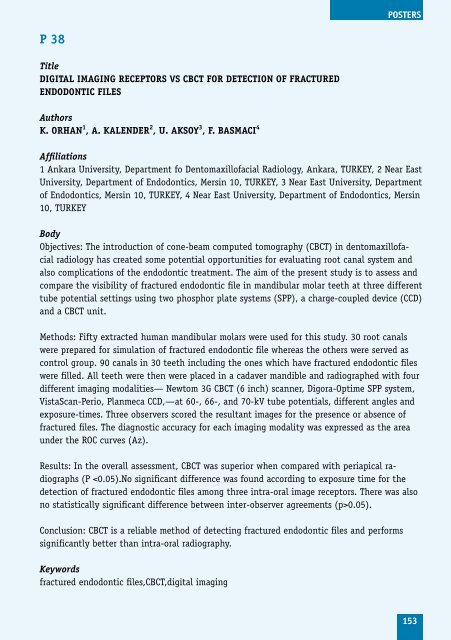Program including abstracts as pdf available here
Program including abstracts as pdf available here
Program including abstracts as pdf available here
Create successful ePaper yourself
Turn your PDF publications into a flip-book with our unique Google optimized e-Paper software.
P 38<br />
Title<br />
DIGITAL IMAGING RECEPTORS VS CbCT FOR DETECTION OF FRACTuRED<br />
ENDODONTIC FILES<br />
Authors<br />
K. ORHAN 1 , A. KALENDER 2 , u. AKSOy 3 , F. bASMACI 4<br />
Affiliations<br />
1 Ankara University, Department fo Dentomaxillofacial Radiology, Ankara, TURKEY, 2 Near E<strong>as</strong>t<br />
University, Department of Endodontics, Mersin 10, TURKEY, 3 Near E<strong>as</strong>t University, Department<br />
of Endodontics, Mersin 10, TURKEY, 4 Near E<strong>as</strong>t University, Department of Endodontics, Mersin<br />
10, TURKEY<br />
Body<br />
Objectives: The introduction of cone-beam computed tomography (CBCT) in dentomaxillofacial<br />
radiology h<strong>as</strong> created some potential opportunities for evaluating root canal system and<br />
also complications of the endodontic treatment. The aim of the present study is to <strong>as</strong>sess and<br />
compare the visibility of fractured endodontic file in mandibular molar teeth at three different<br />
tube potential settings using two phosphor plate systems (SPP), a charge-coupled device (CCD)<br />
and a CBCT unit.<br />
Methods: Fifty extracted human mandibular molars were used for this study. 30 root canals<br />
were prepared for simulation of fractured endodontic file w<strong>here</strong><strong>as</strong> the others were served <strong>as</strong><br />
control group. 90 canals in 30 teeth <strong>including</strong> the ones which have fractured endodontic files<br />
were filled. All teeth were then were placed in a cadaver mandible and radiographed with four<br />
different imaging modalities— Newtom 3G CBCT (6 inch) scanner, Digora-Optime SPP system,<br />
VistaScan-Perio, Planmeca CCD,—at 60-, 66-, and 70-kV tube potentials, different angles and<br />
exposure-times. Three observers scored the resultant images for the presence or absence of<br />
fractured files. The diagnostic accuracy for each imaging modality w<strong>as</strong> expressed <strong>as</strong> the area<br />
under the ROC curves (Az).<br />
Results: In the overall <strong>as</strong>sessment, CBCT w<strong>as</strong> superior when compared with periapical radiographs<br />
(P 0.05).<br />
Conclusion: CBCT is a reliable method of detecting fractured endodontic files and performs<br />
significantly better than intra-oral radiography.<br />
Keywords<br />
fractured endodontic files,CBCT,digital imaging<br />
POSTerS<br />
153


